THE BEAUTIFUL PASSAGES COUVERTS OF PARIS
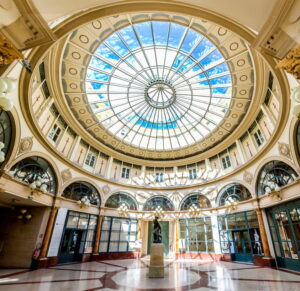
The famous passages couverts—covered passages—of Paris were an early form of shopping arcades, mostly dating from the first half of the 19th century. By the 1850s, there were around 150 covered passages in Paris, although Haussmann’s massive urban renewal program of Paris saw a number of these demolished. Of those that remain, some are still dusty and forgotten, awaiting revitalisation, but there are many that have been beautifully restored to their original Art Nouveau or Neoclassical splendour. Here are just some of them.
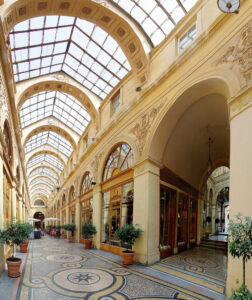
For the visitor especially, the covered passages, or galeries, of Paris are a world away from crowded museums or busy department stores. By the end of the 18th century into the beginning of the 19th, there was a labyrinth of commercial covered walkways across the city with beautiful stained-glass ceilings, mosaic tiled floors and decorative finishes and iron latticework, all bathed in nature light. They were warm, dry places on rainy, muddy days in a time before paved streets and sewers. These delightful spaces soon became the favourite place for the bourgeoisie to shop, patronise the public baths, play billiards, stroll, and socialise in intimate little cafes or small theatres. There were usually residences on the upper floor.
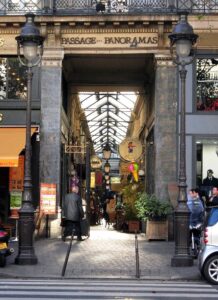
Parisians flocked to them immediately. In his 1867 Les Plaisirs de Paris: Guide Practique, Alfred Delvau described one of them as “so awash with crowds of flâneurs that, each day, from four in the afternoon, one needs to use one’s elbows vigorously to make one’s way through the throng…Why so many people? It’s a place for rendezvous and promenades: a place we look forward to, and once strolling there, we forget all our worries.”
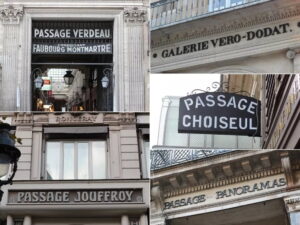
At the height of their popularity in the mid 19th century there were more than 150 covered passages. However, with the advent of the department store around 1850, the galeries began to decline. Today, 18 passages remain.
It’s easy to explore most of these extant passages as the majority are conveniently located in the 2nd and the adjoining 9th arrondissements, so you can stroll leisurely from one to the other.
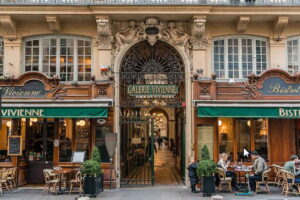
Built in 1823, Galerie Vivienne in the 2nd arr. is considered the most elegant of the covered walkways in Paris. It still has its original mosaic floor, and look out for the names of the former shops at the entrance to each space. Today, it’s home to luxury boutiques, bookshops, fabric shops, cafes and tea rooms.
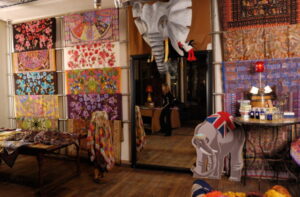
Must-sees include: Wolff & Descourtis, who sell superb silk squares measuring 140cm x 140cm, enough to make a blouse or more commonly, use as a shawl. The silk comes from Como on the shores of the lake, famous the world over for its exquisite silks. These squares are complemented by beautiful cashmeres and velvet jacquards from Lyon.
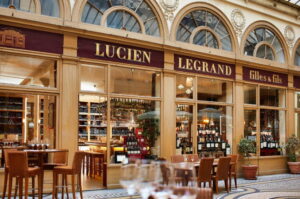
Lucien Legrand Filles et Fils is considered by many to be the best wine shop in Paris with more than 3,000 labels. Established in 1880, the store is more than just a wine shop though, with a bistro, a tasting bar and gourmet epicerie (groceries). You can book a place at one of the regular wine tastings and you can also enjoy fine food with matching wines at their Comptoir de Degustation.
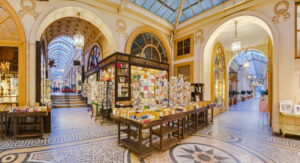
Founded in 1826, Librairie F. Jousseaume is a beautiful bookshop specialising in rare books from the 18th – 20th centuries on subjects ranging from history, literature, travel, theatre and music, as well as lovely old postcards.
One of my favourite French fashion designers, Manuelle Guibal, has her second Parisian boutique in Galerie Vivienne. Her signature styling features natural fibres, especially linen, in a limited palette of colours making this label one of the most sought-after in the city. The store is at the rue de la Banque end.
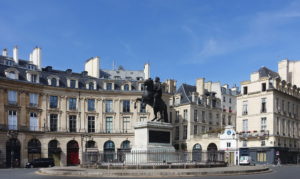
Galerie Vivienne is located a few minutes from Place des Victoires, with its equestrian statue of Louis XIV, at 4 rue des Petit-Champs and running through to rue Vivienne. Nearest metro: Bourse (Line 3) or Pyramides (Line 7).
Just nearby is Galerie Colbert at 2, rue Vivienne. Built in 1826, it was built to be in competition with Galerie Vivienne, although it was never as successful as its rival. Don’t miss the richness of its neoclassical architecture, featuring its marble colonnade and surmounted by a dramatic 15 metre diameter glass dome.
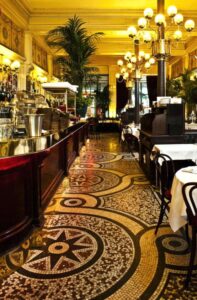
This covered passage is home to the Institut National d’Histoire de l’Art (a research institute) and L’Institut National du Patrimoine (the French national institute for cultural heritage, belonging to the French Ministry of Culture). Note: there are no shops in this Galerie, but the public are free to walk through and perhaps stop off for lunch at Le Grand Colbert brasserie located at the entrance, and famous for its stunning Art Deco style interior.
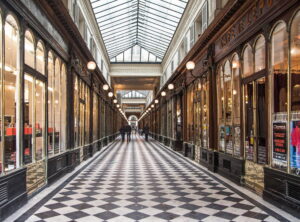
Galerie Véro-Dodat is at 19, rue Jean-Jacques Rousseau in the 1st arr., just near the church of St Eustache, and a short walk from the Louvre. It was built by two charcutiers in 1826 during the Bourbon restoration dynasty, and was one of the first galeries to get gas lighting in 1830. It’s not particularly long, although the black and white diamond-shaped marble paving, gives a sense of perspective.
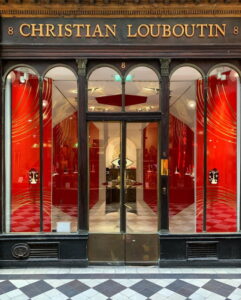
Galerie Véro-Dodat is home to many elegant boutiques for furnishings, interior decoration, art galleries, musical instruments and antique dolls, among others. However, its main claim to fame for fashionistas is the workshop-boutique of shoe king Christian Louboutin–otherwise known as shoe heaven! This luxury shop is located at the entrance of the arcade, at the rue Jean-Jacques Rousseau end. Nearest metro: Les Halles (Line 4) or Louvre Rivoli (Line 1).
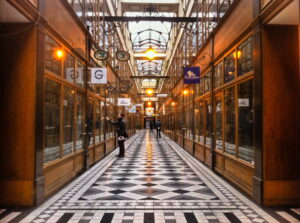
A hidden gem is the beautiful Passage du Grand Cerf, located at 145 rue Saint-Denis in the 2nd arr. Built in 1825 on the site of the Hôtel du Grand Cerf from which it took its name, this is one of the most spectacular Parisian passages, but one of the most secret because it isn’t easy to find.
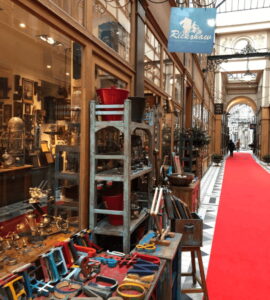
It’s rarely crowded despite being home to a host of tempting artisan shops and high quality jewellers such as Eric et Lydie contemporary jewellery designers, Pour Vos Beaux Yeux, who specialise in vintage eyewear, and Rickshaw, who sell interesting vintage objects and curiosities from around the world.
After all those visual treats, for the perfect break head to Le Pas Sage—a wine bar, perfect to finish your shopping in style . Don’t miss the passage’s spectacular 12 meter high roof structure of wrought iron with beautiful glass roof and first floor balconies. Nearest metro: Etienne Marcel (Line 4)
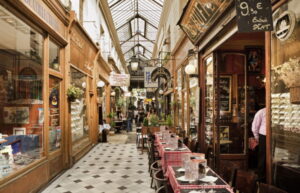
In the Grands Boulevards district in the 9th arr. you will find Passage des Panoramas, at 11 Boulevard de Montmartre. It was built in 1799 and is the oldest of the surviving covered passages in Paris, and the first one to be illuminated with gas lighting in 1816. Its name comes form the two large rotundas that were built at the entrance of the passage—sadly now gone—to display panoramic paintings depicting scenes of Toulon, Rome, Jerusalem, and other famous cities.
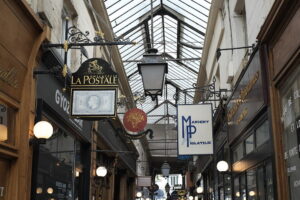
The Passage is home to the Théâtre des Variétés which has been entertaining Parisians since 1807. Passage des Panoramas is known for its philately, coin and old postcard shops. There is also one of the Paris’ best restaurants for gluten-free dining, Noglu. Nearest metro: Richelieu-Drouot (Lines 8 & 9) or Grands Boulevards (Lines 8 & 9)
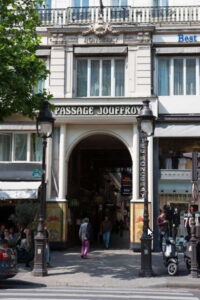
Passage Jouffroy at 10-12 Boulevard Montmartre is a continuation of Passage des Panoramas. Built in 1836, it’s one of the best-known and most visited covered passages in Paris.
It owes its charm to its beautiful iron and glass architecture and for its interesting window displays, and the fact that it houses a charming boutique hotel, the Hôtel Chopin that opened in 1846, a museum and nightclub, the Salon des Miroirs, a former 19th century brasserie. It’s also home to Grévin, Paris’s version of Madame Tussauds waxworks.
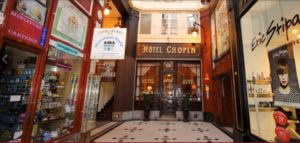
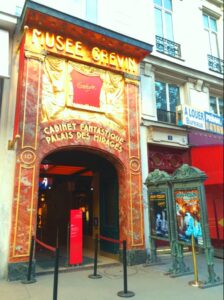
There are quirky businesses such as La Maison du Roy which immerses visitors in a world of boudoirs, castles and costume balls, offering genuine 18th century artwork, furniture and curiosities as well as handmade antique-inspired decorations; Galerie Cannes Fayet, specialising in walking sticks, canes and umbrellas; Pain d’Epices, a wonderful old-fashioned toyshop; there’s Librarie du Passage, founded in 1850, one of the oldest bookshops in Paris, as well as paper specialists and many others.
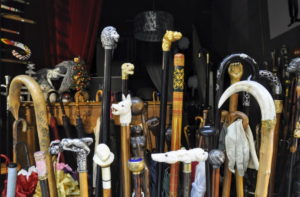
Take a break at Valentin, the unmissable tea room that’s a bastion of traditional French patisserie, viennoiseries and chocolates, all made from scratch. Nearest metro: Richelieu Drouot (Lines 8 & 9).
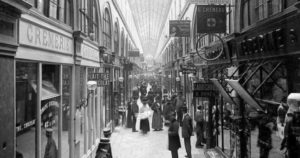
There are many other passages couverts or galeries, to explore such as Passage de Choiseul at 40 rue de Petits Champs in the 2nd arr., and just west of Galerie Vivienne. Nearest metro: Quartre Septembre (Line 3). Spanning 190 metres, it is the longest of the covered passages. For many years it had not made it onto the Monument Historique list, so no public funds were available for its renovation and upkeep. Its signature glass ceiling was covered with ugly netting and wire mesh and it leaked in heavy rain.
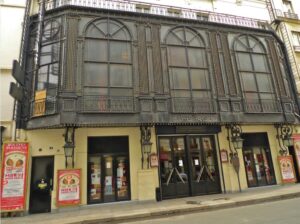
Fortunately, this iconic passage was rescued and revamped in 2013, so now visitors can admire the interior’s glass roof, which has been returned to its former glory, making it bright and luminous. The passage houses one of the most beautiful theatres in Paris, the Théâtre des Bouffes Parisiens, which was inaugurated in 1855 by the composer Jacques Offenbach. The theatre was especially built to perform his opera-bouffes–‘Orpheus in the Underworld’ had its premiere here in 1858.
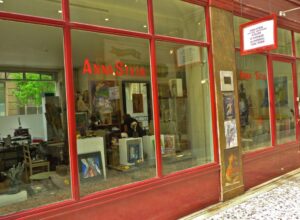
The Passage now has bookshops, a clock-maker, jewellers, art galleries and many different types of cafes and restaurants including a Korean caterer and a Japanese eatery, to relax and enjoy a peaceful break from the hustle and bustle of the city.
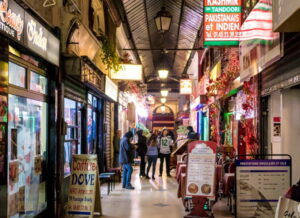
If you find yourself in the Grands Boulevards neighbourhood of the 10th arr., head to Passage Brady at 43, rue du Faubourg-St-Martin. Built in 1828 in two parts, separated by Boulevard de Strasbourg. One side is covered by a traditional glass roof and on the other it is open-air.
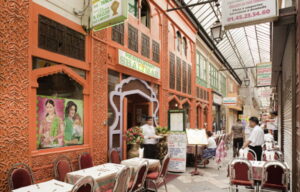
This is perhaps the most exotic of the passages, since nowadays it’s known by locals as ‘Little India’, and it’s easy to see why. You’ll be assailed by the aromas emanating from spice shops such as Epicerie Velan, bazaars, shops hiring colourful costumes, and restaurants featuring Indian, Pakistan, Mauritian and Reunion curries. Restaurant ‘La Reine du Kashmir’ is very well regarded, and ‘Pooja’ is known for its delicious and spicy cuisine. Nearest metro: Chateau d’Eau (Line 4) or Strasbourg St Denis (Lines 4, 8, and 9).
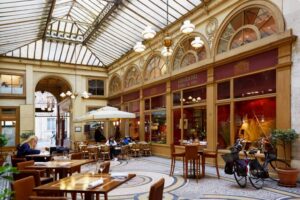
Most of the passages are either listed Historic Monuments or protected by the Local Urbanism/Protection Plan for the city. Galerie Vivienne, for example, is also indexed in the Base Merimee, a database of architectural heritage maintained by the French Ministry of Culture.
Each passage has its own special character, but they have one thing in common: they are all classified as private roads, some open to pedestrians, some not, and are all run by private owners. Aware of the unique heritage value of the passages, in 2002 the Mairie of Paris launched a project to assist owners to conserve their historical value and architectural qualities. Lists of architectural specifications have been drawn up and agreed to by the owners, in exchange for a financial contribution from the City of 25% of the cost of conservation works.
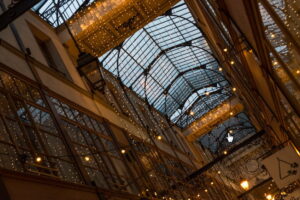
The passages couverts of Paris are often missed by visitors. Visiting a few of them will add another dimension to any exploration of the city. While you enjoy their beauty and the intimacy and variety of the many shops, take a moment to consider how they have managed to live through the years of neglect to emerge with a new lease of life to become an integral part of the city’s architectural and retail treasures.
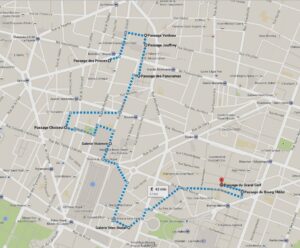


Thankyou once again Cheryl for a wonderful read.When I get to Paris again they will certainly be on my must do list.
Hi Sandy,
I’m so delighted that you enjoyed the story about the Passages in Paris. They are indeed beautiful, and full of fascinating, often one-off little shops selling a range of merchandise that you’d be unlikely to find in say, a department store. Whenever we find ourselves near one of the Passages, we always do a detour to stroll along them.
Best regards, Cheryl